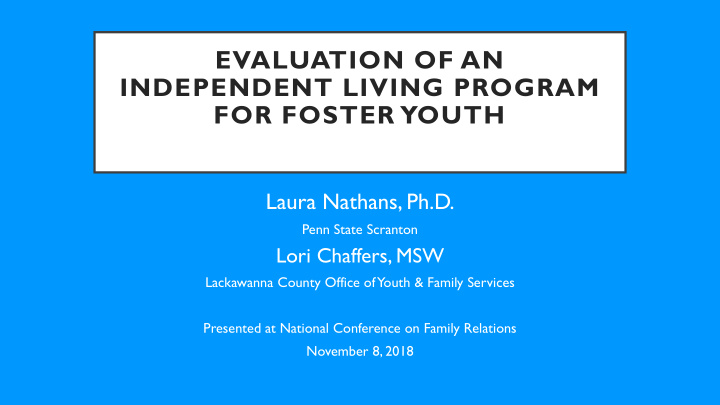



EVALUATION OF AN INDEPENDENT LIVING PROGRAM FOR FOSTER YOUTH Laura Nathans, Ph.D. Penn State Scranton Lori Chaffers, MSW Lackawanna County Office of Youth & Family Services Presented at National Conference on Family Relations November 8, 2018
BACKGROUND • Foster care system does not provide adequate preparation for transition to independent living (Geenen & Powers, 2007). • Youth are unaware of the difficulties of the transition out of foster care until they experience it and regret not making use of Independent Living services when in foster care (Geenen & Powers, 2007). • There is a lack of information regarding IL services available for youth aging out of care (Scannapieco, Connell-Carrick, & Painter, 2007). • Foster youth want more skill-building opportunities to practice, have follow-up, and have in vivo training (Scannapieco et al., 2007)
PROGRAM DESCRIPTION • -A program in a northeastern urban area • -Provides coordinated and comprehensive services, individualized to meet the specific and unique needs • -Youth who have been in care on or after their 14 th birthday through their 21 st birthday This Photo by Unknown Author is licensed under CC BY-ND • -Ensures a smooth, supported, and successful transition into adulthood. • -Focuses on the following areas: support, education, health/mental health, employment, life skills, housing, prevention. • -Also focuses on relationship-building, which enables development of permanent relationships
METHODS • Subjects: • Gender: 53.6% Female, 46.4% Male • Race: 14.3% African American • 10.8% White Hispanic • 53.6% White, • 6% Bi-Racial • Ethnicity: 17.8% Latino • Procedures: • 28 transcripts out of 158 transcripts were selected by pulling cases of varying lengths from database of case notes; cases were selected that were opened between March 2013 and June 2018; is pilot study in preparation for larger study • Seven domains of IL intervention guided categorization of codes
DATA ANALYSIS • Qualitative text analysis (Kuckartz, 2013) was used to code data • Inductive category construction was used to create categories • Twelve cases were coded jointly by first and second author, during which initial categories were created and applied • Discussion of categories and how they were defined was conducted until both coders were coding transcripts similarly. • Codes continued to be added as the authors progressed through transcripts of case notes. • The constant comparative method (Corbin, 1998) was used to develop broader categories within the seven domains of the program and an additional category of case management for general functions of the program.
QUOTES • Health/Mental Health - CW [Name] role will be to ensure all supportive services are in place for the family including ID services and school IEP transition services. • Education - ILC's and CW [Name] took Youth B to tour [Name] College. Youth B loved the facility and ended up applying before he left. • Employment - ILC [Name] also encouraged Youth D. to go to [Employment Program Name] to see if they can assist with finding him employment. ILC [Name] also provided him with a list of jobs that comes out through [Agency Name]. • Life Skills - ILC talked to her about budgeting, savings match and making smart purchases. • Housing - ILC [Name] met Youth D. at [Location] and transported him to [Address]. The agency will be renting Youth D. a room at this location for the next 4 weeks. • Support - CW transported Youth C to [Name] Tailoring for her pants to be fitted, then to the bank, then to [Uniform Store] and [Name] for lunch. Youth C was happy to spend the day with CW.
CW-Related Themes Health/Mental Case Management Support Education Employment Life Skills Housing Prevention Health Comparative Comparative Comparative Comparative Total Comparative Total Comparative Codes Total Comparative Codes Total Total Total Comparative Codes Total Total Codes Codes Codes Codes Codes CW Behavioral CW assistance Family Contact & Job assistance Pregnancy CW Visitation 258 50 College 87 issues & 48 23 with relationship 76 9 4 Visitation Search obtaining Prevention problems building skills housing Obtaining CW Case Seeking /Maintain- CW assistance assistance CW emotional and Assistance with Community management 206 36 4 psychiatrist/ 30 ing Social 12 obtaining vital 47 with 8 2 social support IEP involvement activities medication Security documents transitional Income housing Seeking CW assistance Assistance with Employ- Interagency individual with budgeting 13 SWAN related work 21 Special 1 23 ment 9 21 collaboration MH & money Education Programs counseling management Investigation CW assistance with Job Intellectual General life of child 4 meeting basic 21 20 Maintena 2 10 Disability skills maltreatment needs nce
DISCUSSION • Comprehensive Program - The study showed that the program strengths included the caseworkers’ comprehensive knowledge of systems across each of the domains, which allowed them to help youth successfully navigate various systems. • Support -This program is uncommon in that it focuses on establishing permanent relationships as a key to successful independent living. 64.2% of youth achieved permanency either through adoption or subsidized permanent legal custodianship. This supports previous research highlighting the need for permanent relationships with mentors, foster or birth parents, or other trusted adults (Mares, 2010). • Education - 51.1% of eligible youth completed high school, 10.7 % of youth are currently in high school, and 10.7% of youth obtained their GED. 10% of youth did not graduate high school. The program was successful in linking youth with resources such as an educational exploration and college preparation program. • Attrition - Participation in the Independent Living Program is voluntary. It is offered to every eligible youth, most of whom opt-in to services. However, some youth do not remain in the program for the duration of the program.
QUESTIONS • What human development and family studies theory best fits with the formulation of this study? • What best practices or evidence-based practices do you think will foster success with Independent Living Program outcomes?
Recommend
More recommend